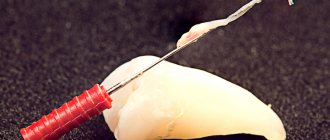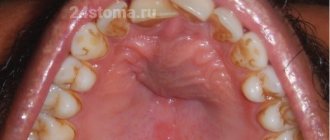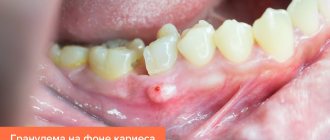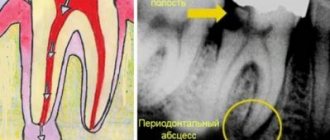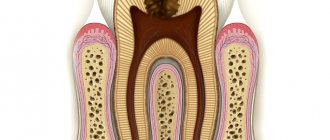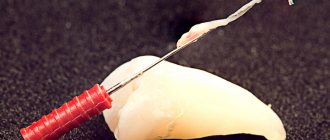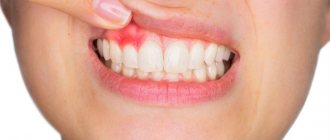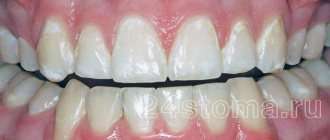Toothache can be caused by various reasons, including dental granuloma, which without proper and prompt treatment can lead to the tooth having to be removed. Therefore, you should never endure toothache, because only in a dental clinic can a dental granuloma be detected and treated.
What is a dental granuloma, what are its symptoms, does a granuloma require mandatory tooth extraction, and what methods are used to treat it in modern dentistry? All these questions will be answered by the material on our website dedicated to the treatment of dental granuloma. What is it - tooth root granuloma?
Dental granuloma is the name of an inflammatory process that affects the connective tissue (periodontal) in the area of the root apex. With the development of inflammation, the structure of the periodontium changes and a dense sac is formed in it - a granuloma. The granuloma is so tightly attached to the apex of the tooth root that it comes out of the gum when the diseased tooth is removed only together with the tooth.
YOU NEED TO REMEMBER: Many people think that a dental cyst and a dental granuloma are the same thing. But that's not true. When a dental cyst forms, a sac also forms, but it is hollow and as the cyst develops it will gradually fill with purulent fluid. A granuloma is a dense sac of inflamed tissue. Also, a granuloma will differ from a cyst in its size. Dentists call granulomas formations up to 0.5 cm in diameter. If the formation has a larger diameter, it is already a cystogranuloma.
Treatment of dental granuloma is possible in 98% of cases thanks to the SIEMENS SLA laser
This is confirmed every day by the successful work of the doctors of the Bionic Dentis dental clinic. In the clinical practice of Bionic Dentis, laser treatment is widely used, and now specialists have presented a unique technique - the first in Russia. It was developed in partnership with the German company Sirona Siemens.
Among Russian patients, a disease such as dental granuloma is especially common. The main reason for this is the low level of dental services provided throughout the country. Public clinics still use outdated techniques. With this approach, it is difficult to obtain a positive effect, and the result of improper therapy is the development of dental granuloma.
What are the possible complications?
The neoplasm itself does not cause any consequences. If an infection gets into the root of the tooth or if inflammation occurs again, it may fester. In this case, a person experiences gumboil, severe pain, swelling and distension of the gums. If dental granuloma is not removed in time, this can lead to troubles:
- The tooth will have to be completely removed.
- The neoplasm can develop into a malignant tumor.
- This pathology often causes osteomyelitis of the jaw.
Tooth granuloma - treatment methods
To treat dental granuloma, various methods are used, which are divided into therapeutic and surgical.
As a rule, the need for surgical intervention arises when the therapeutic course does not produce the desired result.
The list of surgical methods for treating granuloma includes:
- Cystotomy;
- Cystectomy;
- Resection of the apex of the tooth root.
Carrying out operations requires preliminary preparation, and then subsequent rehabilitation and a healing period that lasts a long time. In this case, patients are concerned about pain, discomfort and significant swelling.
However, the main problem of surgical methods is the high likelihood of relapses. In almost 45% of clinical cases, dental granuloma occurs again.
How does the treatment of a cyst differ from the treatment of a granuloma?
Many experts distinguish three forms of the disease: granuloma, cystogranuloma and cyst. Depending on the type, a technique is selected and a detailed treatment plan is drawn up. It is believed that the initial form of granuloma can be treated conservatively, and to get rid of the cyst one cannot do without surgical intervention. This statement is partly true, but when drawing up a treatment plan, you must first of all evaluate the clinical picture. A large cyst (more than 8 millimeters in diameter), which affects the roots of healthy teeth, has penetrated the maxillary sinus, caused a serious abscess or osteomyelitis, and must definitely be removed. Granulomas and cystogranulomas of small sizes in the absence of extensive inflammatory processes with the spread of purulent exudate are today quite successfully treated with antibiotics or endodontic manipulations.
Unique. 100% channel processing. Laser technique
It should be noted that this disease does not occur without a reason. Moreover, he has certain symptoms. You can understand that a patient is developing a granuloma by signs such as the appearance of:
- Abscess on the gum;
- Flux on the gum;
- Feelings of tooth enlargement;
- Pain when eating solid foods;
- Fistula on the gum.
Similar symptoms may also indicate a suppurating dental granuloma. Therefore, the appearance of these disorders requires immediate contact with a dentist. It has been established that purulent lesions quickly spread through the canals and penetrate the bone and other tissues, systematically affecting vital organs - eyes, ears, etc. The result of this is not only severe consequences in the form of a threat to human health, but also to human life.
If you treat this disease in a timely manner, you can get a good result. But the problem is that its symptoms appear only after some time, when it reaches a certain stage. At first, the disease is almost asymptomatic. Many patients may not even realize that they have this dangerous disease. A planned study allows detecting a violation at an early stage. In the panoramic image, its formation is revealed quite clearly. Although the patient may not feel pain or other alarming signals. The only option for detecting the development of the disease is regular medical examination by a dentist.
What is granuloma
If you open Wikipedia, you can read that granuloma is a granulomatous inflammation characterized by the formation of nodules (granulomas) resulting from the proliferation and transformation of cells capable of phagocytosis
. Difficult. But, if you explain it in accessible language and relate it to dentistry, it will be like this:
Tooth granuloma
- nodular inflammation of soft tissues (periodontal), which is often located in the area of the apex of the tooth root. The size of the nodule is about 0.5 cm. The resulting granuloma is the center of the disease. If left untreated, the inflammatory process will continue. The asymptomatic course of the disease is a frequent companion and only X-rays can recognize it. In practice, dental granuloma is often discovered when adjacent teeth are treated.
Treatment not started on time can cause serious complications:
- The appearance of suppuration;
- Due to compression of the nerves, numbness occurs in part of the face;
- Destruction of the jaw leading to a fracture of the lower jaw. The development of the disease leads to fragility and brittleness of the bone. Therefore, a jaw fracture can occur even while chewing solid food;
- Sinusitis formation - this happens in 99% of cases. This disease is also quite severe, accompanied by constant nasal congestion and severe headaches.
SYMPTOMS OF GRANULOMA
The granuloma begins to be asymptomatic. Then comes a certain stage at which the body signals the disease with sharp pain (the first symptom).
Another symptom of the disease is the presence of a foreign body in the oral cavity. This is tissue that has grown greatly as a result of inflammation. It can be easily felt with the tongue.
When the granuloma becomes visible visually, the disease begins to be accompanied by the following symptoms:
- Redness of the gums.
- Swelling of the gums.
- Inflammation of the oral cavity, which is accompanied by an increase in temperature.
- Darkening of the enamel.
- The appearance of pus between the tooth and gum.
- Headache with severe malaise.
- Flux.
Swelling and redness can be on different sides of the tooth. For example, from the inner surface of the gum, from the palate or behind the lips.
When pressing on the inflamed area, the pain intensifies greatly. It has a bursting character and only grows over time.
Let's summarize. The first symptom of granuloma is acute pain. It is accompanied by slight swelling. The next stage is accompanied by sudden changes in body temperature.
Stages of the laser treatment method for dental granuloma
The technique used in clinical practice is particularly complex. Its implementation requires high-tech dental equipment. Moreover, this method shows effectiveness in 98% of cases of treating granuloma.
The application of the methodology in practice is carried out in several stages:
- First, a small hole is drilled on the affected tooth. If the front teeth are damaged, then it is done from behind, on the rest - from the side. This is necessary so that the specialist can get to the root canals in the center of the tooth - its pulp.
- Having provided access to the nerve, the specialist removes the contents of the root canal. It may contain an inflamed dental nerve, as well as infected material used to fill the canal, in case of improper treatment.
- The next step is root canal treatment. For this purpose, our clinic’s dentists use a special device, which is a computer-based root canal cleaning system. With the help of special titanium instruments, translational movements - files carefully controlled by microprocessors - clean the root canal. This gives it not only purity, but also evenness.
- Constant monitoring of canal cleaning is performed with a VDW (Germany) apex locator. The main stages of therapy are monitored using a Xios Sirona Siemens radiovisiograph. Such equipment is available in every office of our clinic. Therefore, the research and therapeutic process occurs continuously.
Complete cleansing and unfilling of the root canal requires some time. Usually it is 2-2.5 hours.
After mechanical cleaning and expansion of the canal, the specialist carries out ultrasonic treatment. According to recent research, a large root canal has microscopic branches in which all kinds of bacteria accumulate, causing many dental diseases. Clearing these tiny tubules with files is impossible. For this purpose, our clinic has an ultrasonic root canal treatment system, Sirosonic Sirona, developed by the German company Siemens. It ensures precise penetration of the disinfectant solution into the tubules and pores, sterilizes the root canal and destroys microbes.
After sterilizing the root canal using chemicals and ultrasound, laser treatment can begin. The clinic’s specialists are assisted in this by the Sirolaser laser dental unit. Penetrating through the root canal, the doctor treats the granuloma with a laser. With the use of a unique flexible laser LED, such a procedure becomes possible even in the presence of a curved canal. Therefore, Sirolaser laser equipment is recognized as the best among other analogues.
Having completed the laser treatment, the doctor proceeds to laser sterilization of the root canals and cavities in the bone tissue. This ensures 100 percent disinfection of infected tissues, preventing recurrence of granuloma in the treated tooth.
Following laser sterilization, the drug is installed. For this purpose, a substance is used that stimulates tissue regeneration and disinfection. This drug has a long period of action, 4-6 months.
Then a light-emitting temporary filling or crown, which is extremely durable, is installed on the tooth.
Treatment of dental granuloma is possible in 1 visit. We offer our patients the world's best achievements in dental treatment.
Surgery
Surgical intervention is necessary for:
- obstruction of the root canals - complex anatomy of the shape, too narrow;
- impossibility of removing old material;
- the presence of a metal pin in the channel - the unit may be destroyed;
- patient’s refusal to remove the orthopedic structure.
Most patients choose rapid removal of the granuloma unit and subsequent implant placement. Because do not want to undergo long-term treatment or change their orthopedic structures.
You can perform an apex resection operation - extraction of a piece of the root with a tumor through a gingival incision. It is also possible to perform hemisection - removal of 1 root with part of the crown from a multi-root unit. In the future, it will be necessary to strengthen the tooth with an orthopedic structure. To carry out these interventions, a number of indications must be met.
In case of tooth decay and acute pain, it is important to immediately contact a specialist and get help. It is necessary to open the dental cavity, go through and clean the canals, create a path for the outflow of pus. Relief occurs immediately and the tooth should be left open.
If swelling of the gingival tissue or cheek occurs, then purulent contents may have come out under the periosteum or oral mucosa. It is necessary to create a place for the removal of pus and start taking antibiotics. After antibiotic therapy and elimination of purulent discharge, further full treatment is possible.
3D tooth root canal filling after laser treatment of granuloma
The final stage of therapy and preparation of the tooth for restoration is filling the root canals using permanent materials - alpha gutta-percha. The peculiarity of this biocompatible medicinal drug is that it does not cause an allergic reaction, does not lead to rejection and is an ideal option for obturation of the root canal.
The specialist re-processes the root canal with an antiseptic using an ultrasonic device. Thus, the opening of the entrance for the filling material into the microtubules is achieved.
The alpha gutta-percha pin is first lubricated with a sealant and then inserted into the root canal. Using the BiFill three-dimensional root canal obturation system, gutta-percha is well heated and pressed into the canal. The pressure of a special instrument, a plugger, helps the molten liquid gutta-percha penetrate into the microtubules, instantly solidifying in them. This is how a three-dimensional network or 3d system of a filled tooth canal is formed.
For Russian patients, this method of filling dental canals is new. But in clinics in the USA and European countries, it has become the gold standard when performing obturation of tooth canals. Our specialists also use this technique in 100% of clinical cases. Thanks to this, we are able to prevent recurrences of dental granuloma.
There is also a simpler analogue of filling canals with gutta-percha by using a standard gutta-percha pin. However, its effectiveness is much lower and the results are far from the original technique.
After filling the root canals of a tooth, a filling, inlay or crown is installed on it.
Causes
There are two main reasons for the formation of the pathological process:
- Consequences of untreated pulpitis (inflammation of the neurovascular bundle). The formation of a carious cavity leads to further destruction of the hard structures of the tooth and the accumulation of microorganisms, which subsequently destroy the pulp. Inflammation and noticeable pain occur. The formation of dental granuloma occurs when the patient endures unpleasant sensations for a long time and the root canals are not treated. The pulp becomes necrotic and pathogens go beyond the unit through the root tips - an intraosseous complication occurs - periodontitis. Also, pathology may appear if caries is treated and a filling is placed without following the protocols - secondary caries. Then the deep cavity will be hidden from view under the filling.
- Violation of the endodontic treatment protocol. Signs of granuloma may appear at the root of the unit, treated and with canals filled with gutta-percha pins. Most often, underfilling leads to the formation of conditions for inflammation of the space left without filling material.
There are also rare provoking factors:
- To be treated with orthodontic equipment without following the doctor’s recommendations;
- traumatization of the unit in the past;
- Inflammatory processes in the maxillary area, infecting through the blood/lymph.
Laser treatment of dental granuloma – contact real professionals!
The capital's dental market is distinguished by the variety of services offered. The attention of patients can be attracted by clinics whose specialists are ready to perform laser dental treatment at a price of 3000-5000 rubles. In fact, they use outdated techniques and equipment that are completely unsuitable for providing such services.
Therefore, the choice of a dental clinic should be approached with special responsibility.
Treatment using the original technique is possible only if:
- Fully equipping the clinic with the necessary equipment - a computer system for root canal treatment Gold (wdv), a Sirolaser dental laser, an ultrasound dental system Sirosonic, a device for 3D canal obturation BeeFill (VDW):
- Whether the clinic’s doctors have certificates in training in laser technologies from Sirona;
- Obtaining valid state certificates for doctors in the specialty: therapeutic dentistry.
When you first visit the clinic, you should ask the receptionist to provide all information regarding your treatment. This approach will help you choose a certified clinic where dental granuloma is treated using high-quality original techniques.
Patients with inflammatory diseases of the jaw bone tissue come to our clinic every day. The clinic treats not only patients from Moscow, but also St. Petersburg, as well as other cities of the Russian Federation and CIS countries. The ability to carry out treatment in just 1 visit allows nonresident patients to specifically come to Moscow for treatment for only 1 day.
Symptoms
In dental granuloma, most often the symptoms are not very clear, so the patient may not be aware of the pathology for a long time. The tooth itself will not hurt, only when biting and exposure to hot foods - symptoms suitable for all types of periodontitis.
With a decrease in immunity (hypothermia, infection, surgery), the inflammatory process may worsen. This is how they appear:
- sharp, shooting pain that intensifies when biting one unit;
- swelling of gingival tissue (accumulation of pus) in the projection of the root apex;
- pain in the gums when pressed.
The period of exacerbation of granuloma of a tooth with a pin may subside over time, and then the pathological process will become chronic.
We were the first in the Russian Federation to master the German method of treating dental granuloma with a laser!
The specialists of the Bionic Dentis clinic were the first in the Russian Federation to master the method of treating dental granulomas with a laser back in 2007. During this time, our dentists and endodontists have gained extensive experience in this area. We can safely say that this is the largest experience in Russia and the CIS countries.
We are ready to demonstrate the results of our successful work with a large collection of images and computed tomography scans of patients before and after treatment.
On this page you can familiarize yourself with the clinical cases of our real patients who were treated by us.
Our statistics: 96% of cases of granuloma are successfully cured using the therapeutic method of laser treatment.
Symptoms of the disease
Note that the disease lasts for a long time without obvious symptoms. If a patient experiences pain at the base of the tooth when biting hard food, he usually associates it with some other diseases and processes. More advanced stages are characterized by darkening of the tooth, and the patient’s temperature rises. Most of the situations when a granuloma is detected occur completely by accident. When treating periodontitis, during prosthetics and in a number of other cases, the dentist performs an x-ray, which shows the dark part at the base of the tooth root - granuloma.
X-ray imaging is the most effective method for establishing the inflammatory process at the root. That is why, if you suspect this disease, we recommend that you consult a doctor, he will take a picture. The practical experience of the doctor and his personal observations are also important in establishing the disease. Untimely treatment of this disease can lead to its increase, and this will put pressure on neighboring tissues, which is accompanied by pain. If you look at photographs of the same tooth, taken immediately after visiting a specialist, and then after some time, you can definitely observe a decrease in the dark part at the root of the damaged tooth.
Treatment of dental granuloma
For more than 10 years, we have collected a large collection of “before” and “after” images of granuloma laser treatment.
ALL IMAGES ARE CLICKABLE
Ozerov Petr Vladimirovich
Chief physician. Dentist, implantologist, orthopedist, surgeon. Laser dentistry specialist
More details
Eremina Anna Arturovna
Dentist therapist
More details
Werner Elena Vladimirovna
Dentist periodontist
More details
Diagnosis of pathology
If granuloma occurs in the mouth, this diagnosis is confirmed by a dentist. If the formation has grown inside the gum, instrumental diagnostics are indispensable. To determine the exact location, an x-ray examination is required.
It is imperative to send the nodular neoplasm for histological examination. This will help accurately determine the diagnosis, and most importantly, exclude a malignant nature. Often the biological material is cut out completely, that is, not partially, but the tooth granuloma is completely removed.
Patient Irina, 37 years old.
A patient came to the dental clinic at her place of residence with complaints of gumboil, pain in the gums, increased body temperature and general malaise. A study was carried out - a panoramic image, which showed a dental granuloma. When contacting various specialists, she was recommended to remove the damaged tooth.
But the patient was not satisfied with this prospect, and she made an appointment with a doctor at the Bionic Dentis clinic. After a thorough examination, a specialist from our clinic suggested laser treatment for granuloma. The patient agreed.
As a result, the treatment was carried out using the Sirolaser laser according to the standard protocol.
After 8 months, the bone tissue was completely restored, all disorders were eliminated. The patient underwent 3D root canal filling and restoration was installed.
By contacting the Bionic Dentis clinic for laser treatment of dental granuloma, you are choosing the world’s best method of therapeutic treatment of this disease.
We achieve complete elimination of granuloma with a 100% guarantee!
You will receive the highest quality treatment that can be found in Moscow, since we work not according to Russian, but according to European standards of endodontics.
As a result of our treatment, the granuloma on the tooth will disappear in 6-12 months, and treatment requires only 1 visit to the clinic. We will save the tooth from removal and save you from the need to install an implant.
Should I treat or remove a tooth for granuloma?
In most cases, a tooth with a granuloma can be saved - for this purpose in modern dentistry there are a lot of effective techniques, most of which we discussed above. But it is natural that treatment should be done without extreme measures - it should not be postponed until the pain in the tooth becomes unbearable, and the cheek swells from swelling.
If you want to keep your teeth intact and healthy, you must remember one very simple rule - even the slightest pain, slight discomfort that occurs in the teeth when eating or on its own is already a serious reason to see a dentist! The sooner a granuloma is diagnosed, the higher the chances of saving your tooth!
